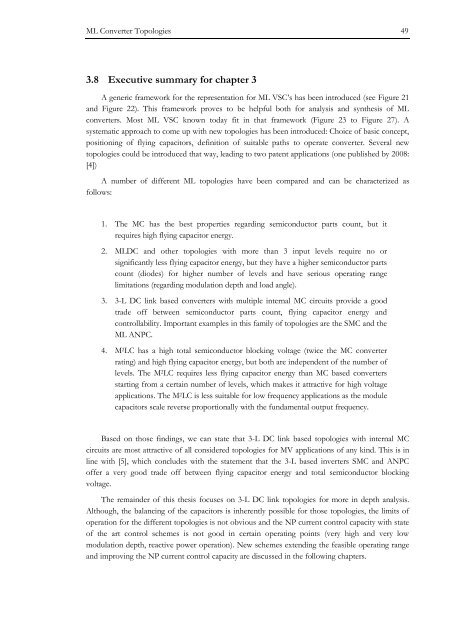Christoph Haederli - Les thèses en ligne de l'INP - Institut National ...
Christoph Haederli - Les thèses en ligne de l'INP - Institut National ...
Christoph Haederli - Les thèses en ligne de l'INP - Institut National ...
Create successful ePaper yourself
Turn your PDF publications into a flip-book with our unique Google optimized e-Paper software.
ML Converter Topologies 49<br />
3.8 Executive summary for chapter 3<br />
A g<strong>en</strong>eric framework for the repres<strong>en</strong>tation for ML VSC’s has be<strong>en</strong> introduced (see Figure 21<br />
and Figure 22). This framework proves to be helpful both for analysis and synthesis of ML<br />
converters. Most ML VSC known today fit in that framework (Figure 23 to Figure 27). A<br />
systematic approach to come up with new topologies has be<strong>en</strong> introduced: Choice of basic concept,<br />
positioning of flying capacitors, <strong>de</strong>finition of suitable paths to operate converter. Several new<br />
topologies could be introduced that way, leading to two pat<strong>en</strong>t applications (one published by 2008:<br />
[4])<br />
A number of differ<strong>en</strong>t ML topologies have be<strong>en</strong> compared and can be characterized as<br />
follows:<br />
1. The MC has the best properties regarding semiconductor parts count, but it<br />
requires high flying capacitor <strong>en</strong>ergy.<br />
2. MLDC and other topologies with more than 3 input levels require no or<br />
significantly less flying capacitor <strong>en</strong>ergy, but they have a higher semiconductor parts<br />
count (dio<strong>de</strong>s) for higher number of levels and have serious operating range<br />
limitations (regarding modulation <strong>de</strong>pth and load angle).<br />
3. 3-L DC link based converters with multiple internal MC circuits provi<strong>de</strong> a good<br />
tra<strong>de</strong> off betwe<strong>en</strong> semiconductor parts count, flying capacitor <strong>en</strong>ergy and<br />
controllability. Important examples in this family of topologies are the SMC and the<br />
ML ANPC.<br />
4. M 2 LC has a high total semiconductor blocking voltage (twice the MC converter<br />
rating) and high flying capacitor <strong>en</strong>ergy, but both are in<strong>de</strong>p<strong>en</strong>d<strong>en</strong>t of the number of<br />
levels. The M 2 LC requires less flying capacitor <strong>en</strong>ergy than MC based converters<br />
starting from a certain number of levels, which makes it attractive for high voltage<br />
applications. The M 2 LC is less suitable for low frequ<strong>en</strong>cy applications as the module<br />
capacitors scale reverse proportionally with the fundam<strong>en</strong>tal output frequ<strong>en</strong>cy.<br />
Based on those findings, we can state that 3-L DC link based topologies with internal MC<br />
circuits are most attractive of all consi<strong>de</strong>red topologies for MV applications of any kind. This is in<br />
line with [5], which conclu<strong>de</strong>s with the statem<strong>en</strong>t that the 3-L based inverters SMC and ANPC<br />
offer a very good tra<strong>de</strong> off betwe<strong>en</strong> flying capacitor <strong>en</strong>ergy and total semiconductor blocking<br />
voltage.<br />
The remain<strong>de</strong>r of this thesis focuses on 3-L DC link topologies for more in <strong>de</strong>pth analysis.<br />
Although, the balancing of the capacitors is inher<strong>en</strong>tly possible for those topologies, the limits of<br />
operation for the differ<strong>en</strong>t topologies is not obvious and the NP curr<strong>en</strong>t control capacity with state<br />
of the art control schemes is not good in certain operating points (very high and very low<br />
modulation <strong>de</strong>pth, reactive power operation). New schemes ext<strong>en</strong>ding the feasible operating range<br />
and improving the NP curr<strong>en</strong>t control capacity are discussed in the following chapters.
















